Use of Contents of First-Aid Kits & Packets

Illustration showing the Medical Supply Section, General Depot, Khorramshahr, Iran. The image above was taken in December, 1944.
Introduction:
The following list has been produced in order to offer an explanation of exactly how the contents of the various First-Aid Kits and Packets supplied to the US Army should be used, and describes their application. In addition to the contents of the kits themselves, the application of Medical forms has also been included in this article for completeness.
During training, troops would have been familiarized with the majority if not all of these materials, since they might have been called upon to use any of the following items in an emergency. Where possible, Medical Department Item and Form Numbers have been added to items for completeness.
Application of Drugs and Compounds:
Aloin Compound Tablets (Item # 1057000):
As a laxative. Take one or tablets at night, if constipated.
Ammonia, Aromatic, Inhalant (Item # 9102500):
For fainting, crush and hold near nose as directed on container.

Ammonia Inhalants, Unit No. 105, 10 per Unit, graphic & written instructions as found on 10 Ammonia Inhalants, 4 c. c. each, manufactured by Davis Emergency Equipment Co., Inc., Newark, New Jersey, Made in U.S.A.
Ammoniated Mercury Ointment (Mercuric Ointment, Ammoniated) (Item # 9114500):
For mild skin infections. Spread thinly over affected areas.
Caution: Not to be applied if iodine has already been used.
Amyl Nitrite (Item # 1069000):
For use after exposure to hydrocyanic acid gas. Break container in piece of cloth and inhale fumes. Repeat three times if necessary.
Aspirin (Acid Acetylsalicylic) Tablets (Item # 1010000):
For slight aches or pain. Take one or two tablets repeating not oftener than every 3 hours, as needed. No more than 12 tablets should be taken in a 24 hour period.
Atabrine Tablets (Item # 1084500):
For prevention of symptoms of malaria. Take first dose (one tablet) in morning and second dose (one tablet) in evening, after meals, on 2 days of each week; skip 2 or 3 days between the days of taking atabrine. Start to take atabrine on the first day spent in a malaria area and continue to take it as long as located in the area.
Benzedrine Tablets (Item # 1098500):
For relief of extreme mental fatigue take one tablet. This dose may be repeated at intervals of every 6 hours, if needed. A total of only three such doses should be taken in 1 week except under operations of extreme length, when up to six such doses may be used. For the relief of physical fatigue, take two tablets. This dose may be repeated at intervals of every 6 hours, if needed. Never take a total of more than three such doses within a period of 1 week.
Bismuth Subcarbonate Tablets (Item # 9103000):
For severe diarrhea. Take 4 to 6 tablets, three to four times daily until diarrhea stops.
Boric Acid Ointment (Acid, Boric, Ointment) (Item # 9101000):
For burns, windburn, and chafing. Spread thinly over affected area.
Burn Injury Set (Sulfadiazine Ointment [5%]; on Wooden Applicator) (Item # 9103800):
Use wooden applicator to spread ointment evenly over burned surfaces or onto dressing which is to be applied to these surfaces.
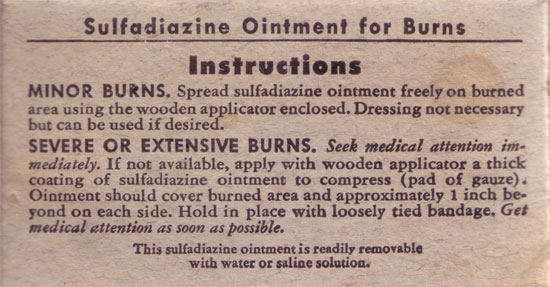
Burn-Injury Set, printed instructions as found on rear of box, produced by Lambert Pharmacal Co., St. Louis, Missouri, Made in U.S.A.
Copper Sulfate Solution (Item # 9107500):
For phosphorous burns. Cover burns with cotton pads wet with copper sulphate solution. Then remove coated phosphorous particles with forceps.
Caution: Do not use in eyes.
Dichloramine-T in Triacetin (Item number unknown):
For liquid mustard on skin. Blot skin dry. Dab cotton pad, dampened with solution, repeatedly on contaminated area.
Caution: Do not use in eyes.
Eye and Nose Drops (Item # 9109100):
For relief of pain and congestion in eyes and nose. Use one or two drops in eye or two drops in nostril. Apply as often as needed.
Eye Solution M-1 (Item # 9109525):
For lewisite in eyes. Open eye, using gentle force if necessary. Drop two to four drops into eye. Apply a little solution to eyelids.
Caution: Apply only once.
Foille (Item number unknown):
For burns or frostbite. Spread evenly over injured surface or onto dressings which are to be applied to these surfaces. Since in cold climates the temperature of Foille may become extremely low without the ointment solidifying, care must be taken before it is applied to be sure that the ointment is warmed to near body temperature, otherwise it may cause further harm to the burned or frostbitten part of the body.
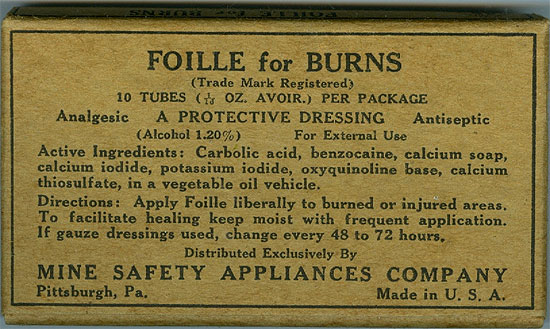
Foille for Burns, printed instructions for use as found on 10 Tubes of Foille for Burns, distributed exclusively by Mine Safety Appliances Company, Pittsburgh, Pennsylvania, Made in U.S.A.
Foot Powder (Item # 9109600):
For protection of the feet, and for athlete’s foot. Wash the feet; dry thoroughly; apply foot powder, especially to soles of feet and between toes.
Hydrogen Peroxide Solution (Item # 1228500):
For liquid lewisite on skin. Blot skin dry. Dab cotton pad dampened with solution repeatedly on contaminated area.
Caution: Do not use in eyes.
Insect Repellent (Item # 9120110):
For keeping away insects. Turn bottle upside down and spread a small amount of liquid over exposed skin surface.
Iodine Applicator (Item # 3611000) :
For application to small scratches.
Iodine Swabs (Item # 9112000):
For sterilization of the skin around a wound. Remove cap from applicator crush where marked “Crush here.” Apply to edges of wound and surrounding skin. Do not apply to wound itself.
Morphine Tartrate Solution (½-Grain) (Item # 9115700):
For the relief of severe pain. Remove transparent head of morphine syrette. Grasp wire loop and push the wire in to pierce inner seal, turning if necessary. Take care not to touch needle with fingers or any other object. Pull out and discard wire, thrust needle through skin at least half its length, and inject solution by slowly squeezing syrette from the sealed end. That part of the body which can be most quickly and easily exposed, such as the loose skin of the abdomen, the thigh or the upper arm, should be used for the place of injection.
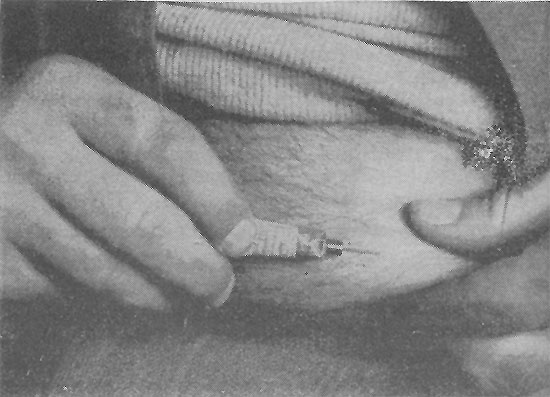
Illustration taken from FM 21-11 (First Aid for Soldier) showing the administration of a single syrette of Morphine Tartrate (Item # 9115700) for severe pain relief.
Pontocaine Compound Ointment (Item # 1354400):
For relief of itching or pain caused by vesicant agents (war gases). Apply to burned skin and gently rub in.
Protective Ointment M-4 (Item # 9118700):
For liquid vesicants (war gases) on skin. Blot skin dry. Apply ointment with cotton pad and rub in for 20 seconds; remove ointment; repeat application, rubbing in and then removing ointment three or four times.
Salt Tablets (Item # 1176000):
For prevention of heat cramps and heat exhaustion. Also to be added to drinking water if suffering with diarrhea or dysentery. Add two tablets to each canteenful of drinking water, if sweating a great deal, or if having diarrhea or dysentery.
Silver Protein, Mild Tablets (Item # 9119000):
For inflammation of the eye. Dissolve one tablet in a spoonful of water. Pour solution in the eye every 3 hours.
Sodium Bicarbonate and Peppermint Tablets (Item # 1418000):
For upset stomach or indigestion. Take two tablets every 30 minutes, for not more than three doses.
Solution for Athlete’s Foot (Frazer’s Solution) (Item # 9109800):
For athlete’s foot. Turn bottle upside down and supply a small amount by rubbing open end on the affected surface.
Caution: Do not use oftener than twice a day
Suction Kit (Item # 3705500):
For first aid for snake or poison insect bites, and for wounds caused by poison arrows or other misiles.
- Apply tourniquet between body and bite. Apply above knee in foot and lower leg bites; above elbow in hand and forearm bites. Loosen tourniquet ever 20 minutes for 10 or 15 seconds
- Apply iodine to area of bite and to blade for making incision.
- Make cross incisions ¼ inch long and ¼ inch deep through each fang mark.
- Apply suction to wound, using small size cup for fingers and toes and larger size cup for other arers. Keep up suction for at least three 20-minute periods. If there is a great amount of bleeding from the incision, tighten tourniquet further, or place a gauze compress on the wound and press the thumb or fingers firmly over the incisions.
- After suction has been completed, remove tourniquet, sprinkle sulfanilamide into incisions, and apply a sterile dressing.
Sulfadiazine Tablets (Wound Tablets) (Item # 9120400):
For prevention of infection in wounds. Take eight tablets orally, followed by a large amount of water. If sweating has been great or if large amounts of water cannot be taken both with the drug and for 24 hours afterwards, do not take any of these tablets.
Sulfaguanidine Tablets (Item # 1462600):
For blood diarrhea. Take four tablets every four hours day and night, until bowel movements are normal. If no improvement in 4 days, take no more tablets.
Sulfanilamide in Sterile Individual Double Wrapped Envelope with Shaker Top (Item # 9121100):
For prevention of infection in wounds. Sprinkle contents of one shaker-top envelope into the wound.
Sulfanilamide Tablets (Item # 1463700):
For prevention of infection in wounds. Take 12 tables orally, followed by a large amount of water. If sweating has been great or if large amounts of water cannot be taken both with the drug and for 24 hours afterwards, do not take any of these tablets.
Vitamins (Multivitamin Capsules or Tablets) (Item number unknown):
To be taken when on very limited rations. Take two capsules or tablets each day.
Water Purification (Halazone) Tablets (Item # 9121805):
For purification of drinking water. Use according to direction on container.
Application of Dressings and Bandages:
Dressing, First-Aid, Carlisle Model, Small (Item # 2030000):
For dressing medium sized wounds.
Dressing, First-Aid, Carlisle Model, Large (Item # 9205000):
For dressing large wounds.
Bandage, Gauze Compress, 4 x 4 Inches (Item # 9200200):
For dressing small wounds.
Bandage, Gauze Compress, 2 x 2 Inches (Item # 9200400):
For dressing small wounds.
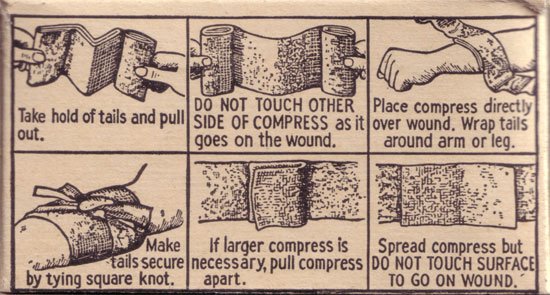
Bandage Gauze Compress, graphic instructions for application and use of gauze compresses, made by Guild Foundations, New York City, New York, Made in U.S.A.
Bandage, Gauze, Adhesive (Item # 9200000):
For quick dressing of small cuts, scratches or blisters.
Bandage, Triangular (Item # 9204000):
For making slings and for bandaging wounds or injuries requiring a large dressing. It can also be used a as tourniquet and for holding splints in place.
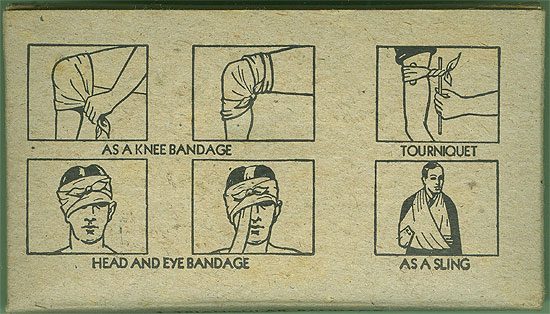
Triangular Bandage Compressed, 50 In. x 36 In. x 36 In., graphic instructions as found on box, manufactured by Millburn Mills, Inc., 145 Sixth Avenue, New York City,N.Y., Made in U.S.A., and showing its plethora of uses.
Eye Dressing (Item number unknown):
For dressing eye wounds, or an eye with a foreign body in it.
Bandage, Gauze, 4 Inches x 6 Yards (Item # 9201500):
For holding dressings or splints in place.
Cotton, Absorbent, Compressed (Item # 2013000):
For plugging ear canals to protect against cold and wind, also as protection for eardrums.
Cotton Pads (Item # 9211800):
For removal of liquid vesicant agents, and for application of gas decontaminating solutions.

Picture showing two sides of an Acme Cotton Products Co., Inc., New York, New York, Made in U.S.A., produced Cotton Pads box, and stating its use for vesicant patients. The large “6” digit is representative of the item’s presence in 9776400 – Kit, First-Aid, Gas Casualty, Complete. All items in this kit bear similar markings.
Eye Dressing Set (Item # 9109500):
Contains 2-Inch Eye Pads; Double-Strip Adhesive Plaster Packets; Boric Acid Ointment; Butyn Sulfate and Metaphen Ophthalmic Ointment.
For eye discomfort caused by exposure to wind or due to dust getting into eyes, squeeze small amount of boric acid ointment onto the inner surface of the lower lid. If there is severe eye pain due to a foreign body which is not easily removed, apply a small amount of butyn sulfate and metaphen ophthalmic ointment onto the inner surface of the lower lid and cover the eye with an eye pad held in place by strips of adhesive plaster.
Caution: Do not rub the eye.
Plaster, Adhesive (1 Inch x 5 Yards) (Item # 2034000):
For holding on dressings.
Safety Pins (Item # 7878000):
For fastening dressings and slings.
Scissors (Item # 9369000):
For cutting bandages, removing clothes from wounds, and other emergency needs.
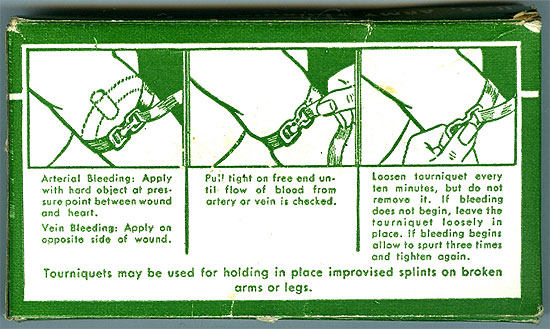
Unit No. R-8-AR, graphic & written instructions as found on U.S. Army Tourniquet, manufactured by E. D. Bullard Co., 275 Eighth Street, San Francisco, Made in U.S.A.
Tourniquet (Item # 9378000):
For stopping bleeding and for snake bite.
Application of Medical Forms:
Issue Slip – Expendable Medical Property (W. D., M. D. Form # 16a):
Made out and signed by the Officer in charge of the ward or department. Names of articles desired will be written as they appear in the Medical Supply Catalog. Slip will be completed by the Officer in charge, who will insert the date and receipt same. Filed at the Medical Supply office.
Issue Slip – Nonexpendable Medical Property (W. D., M. D. Form # 16b):
Made out and signed by the Officer in charge of the ward or department. Names of articles desired will be written as they appear in the Medical Supply Catalog. Slip will be completed by the Officer in charge, who will insert the date and receipt same. Filed at the Medical Supply office.
Credit Slip – Nonexpendable Medical Property (W. D., M. D. Form # 16c):
Made out and signed in duplicate by the Officer charge of the ward or department where the property has been in use. Names of articles will be written as they appear in the Medical Department Supply Catalog. If property to be turned in is unserviceable from any cause other than fair wear and tear in the military service, a statement to that effect will be attached showing what action has been taken to fix responsibility. Both the original and duplicate slip will be completed by the receipt of the storekeeper, who will insert the date. The original will then be returned to the Officer turning in the property for file with his retained memorandum receipt, and the duplicate will be filed at the Medical Supply office.
Exchange Slip – Nonexpendable Medical Property (W. D., M. D. Form # 16d):
Made out and signed by the Officer in charge of the ward or department for which the serviceable property is needed. Names of articles desired will be written as they appear in the Medical Department Supply Catalog. If property to be turned in is unserviceable from any cause other than fair wear and tear in the military service, a statement will be attached showing what action has been taken to fix responsibility. The slip will be completed by the receipt of the Officer in charge, who will insert the date. It will then be filed at the Medical Supply office.
Hospital Laundry List (W. D., M. D. Form # 21):
Copy sent to The Surgeon General, with the voucher for laundry service in case the service is being accomplished by a civilian laundry. A copy sent to The Surgeon General as a monthly report in case the service is being accomplished by a Government-owned laundry. One copy retained.
Contract for Laundry Work (with appendix sheet “A”) (W. D., M. D. Form # 42):
Six copies. Three copies sent to The Surgeon General or corps area surgeon for approval. Three authenticated copies prepared and distributed as follows: One copy for the contracting Officer, one to the Returns Officer, General Accounting Office, and one to the distributing Officer.
Statement of the Hospital Fund (W. D., M. D. Form # 49):
Two copies. Original to The Surgeon General through the Corps area Surgeon. Retained copy for file.
Employee’s Certificate of Indebtedness for Hospital Service (W. D., M. D. Form # 49a):
Three copies. Marked “Original”, “Duplicate”, and “Triplicate.” Two copies to the Officer under whom the employee is serving. One copy retained by the Commanding Officer of the hospital.
Report Sheet for Report of Sick and Wounded (W. D., M. D. Form # 51):
Two copies. Original with report cards and other records to the Corps area Surgeon for checking and then forwarded to The Surgeon General. Copy filed.
Register Cards (W. D., M. D. Form # 52):
Two copies. Original to the Corps area Surgeon, along with Form 51 (Report Sheet for Report of Sick and Wounded). Copy filed.
Index Record of Patients (Card) (W. D., M. D. Form # 52a):
Register index. One copy. Kept in the hospital and prepared by all hospitals in peace or war, wherever located. Also use for keeping the “diagnosis index” and other indices at fixes hospitals in addition to its use as a nominal index of patients.
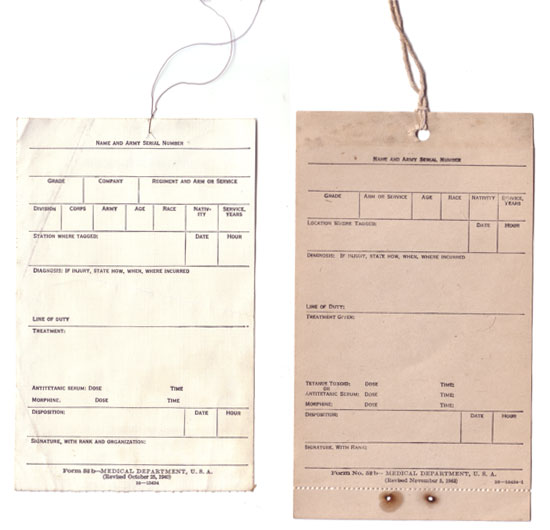
Two variations of Form # 52b (Emergency Medical Tag). The example shown on the left is early – pre -WW2, revised in October 25, 1942. The tag shown on the right was revised November 5, 1942. Note the less specific details needed on the latter example.
Emergency Medical Tag (W. D., M. D. Form # 52b):
Used only in the field. Two copies. Original attached to all sick, wounded and dead, as soon as practicable.
Field Medical Card (W. D., M. D. Form # 52c):
One Copy. Started at the first hospital in the field where treatment is furnished. Accompanies the patient until return to duty, death or arrival in the Zone of Interior. Removed and sent with the monthly report of sick and wounded to the Chief Surgeon Corps or Corps area Surgeon, as the case may be, for transmittal to The Surgeon General.
Field Medical Record Jacket (W. D., M. D. Form # 52d):
For field use. Used for inclosing the field medical card, emergency medical tag and any other clinical record of value.
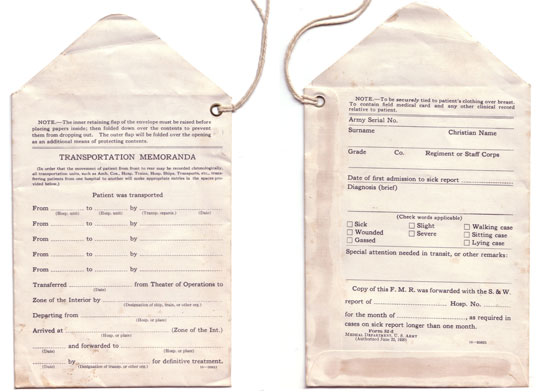
Picture showing both the obverse and reverse of W. D., M. D. Form # 52d. As can be seen, this example has a more substantial metal eyelet and string structure for securing the form to the patient.
Surgeon’s Request for Service Record (W. D., M. D. Form # 54):
Used by the Commanding Officer of hospital to make direct call upon the proper organization CO for the soldier’s service record in the event of failure to receive same in due time.
Clinical Record, Brief (W. D., M. D. Form # 55a):
A clinical record will be kept by fixed hospitals in time of peace or war, excepting those serving in a Theater of Operations. This form and 55j (Clinical Record, Electrocardiograph Report) are used for every patient treated in hospital and for serious cases treated in quarters.
Malarial Register (W. D., M. D. Form # 56):
Prepared for every case or carrier of malaria and should be kept up to date until patient is definitely cured or terminates his military service. In the event of a transfer, accompanies the patient to his new station. In the event of termination of his military service, will be sent to The Surgeon General.
Report of Dental Service (W. D., M. D. Form # 57):
Rendered monthly from every station and separate command where a Dental Officer has been on duty during the month. If post is under the immediate control of the War Department, report is sent direct The Surgeon General. One copy retained. If forwarded through the Corps area Surgeons, two copies are forwarded and one is retained.
Surgeon’s Morning Reports of Sick (W. D., M. D. Form # 71):
Signed each day by the Medical Officer responsible for its rendition. Promptly forwarded to the organization Commander who will enter the strength of the command.
Morning Report of Ward (W. D., M. D. Form # 72):
Rendered each morning by Ward Officer. Sent to the Registrar along with clinical records, etc., of completed cases. This is not a permanent record.
Consolidated Morning Report of Wards (W. D., M. D. Form # 72a):
Kept by the Registrar of the hospital.
Diet Card (W. D., M. D. Form # 73):
Made out daily by the Ward Officer and sent to the hospital mess. Not a permanent record.
Mess Account (W. D., M. D. Form # 74):
Kept by Noncommissioned Officer in charge. Filled at the end of every month with retained hospital fund papers for that month.
Patient’s Property Card (W. D., M. D. Form # 75):
Made out in duplicate. Original filed with hospital records; duplicate given to patient.
Patient’s Property Tag (W. D., M. D. Form # 76):
Used for identification of patient’s property.
Venereal Prophylaxis Slip (W. D., M. D. Form # 77):
Record of prophylactic treatment. Authenticated daily by the initials of the Officer in charge of prophylactic station. May be destroyed after 3 months.
Syphilitic Register (W. D., M. D. Form # 78):
Maintained for each person in active military service who has syphilis. Kept on file in the office of the Surgeon. On “cure” or separation from the service, the register will be forwarded to The Surgeon General.
Register of Dental Patients (Card) (W. D., M. D. Form # 79):
Made for every person admitted to a dental clinic for dental treatment.
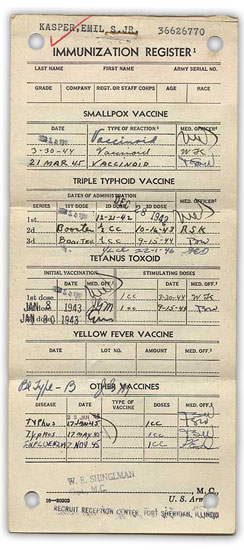
Late-WW2 issue Immunization Record which was to be filled out and maintained for every member of the Armed Forces.
Image courtesy of Hardscrabble Farm
Immunization Register (W. D., M. D. Form # 81):
Made out in duplicate. Original in cases of Officers, Warrant Officers, and Nurses to the person concerned. Original in cases of Enlisted Men to the organization CO for entry on soldier’s service record. Duplicate copy will be filed in an alphabetical immunization file of the medical department records of the station or command to which the individual belongs.
Statistical Report (first and second sections) (W. D., M. D. Form # 86ab):
Rendered by the Surgeon of every separate station or command. Made out in triplicate.
Statistical Report (third section) (W. D., M. D. Form # 86c):
See above remarks.
